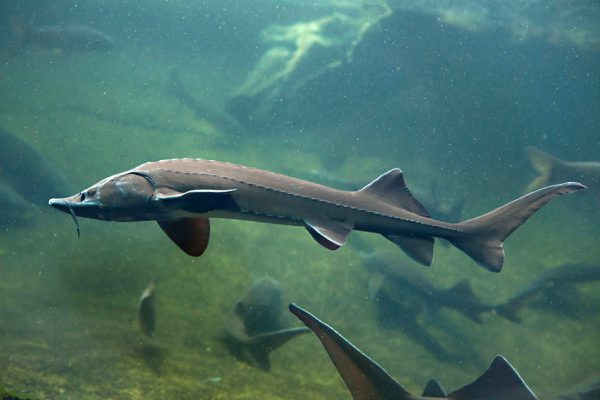Sturgeon
Sturgeons are the most valuable of aquatics in the world. Their different types live in America and Caspian Sea. Sturgeons which live in the fishes basin of the Caspian Sea are included as Acipenser and Huso Species, they are considered as the Migratory Fishes. Over the last years, in our country, using Sturgeon is popular.
Sturgeon is farming in warm water and earth pools as well as in concrete and fiberglass basins in order to extract the caviar and meat. The farming species of sturgeon in Iran including Acipenser ruthenus and Huso huso. As the Sturgeon grows slowly, selecting the proper food is important, having the proper level of energy and supplies all required elements for fish under variable climatic conditions of the country causes the fish’s grow to be coordinate with the time schedule of the farmers, on the other hand, it prevents the waste of time and growth reducing.
The advantages caused the Raman Extruded Food to be considered as the best choice for the Sturgeon’s Food:
- A balance between the ratio of Protein and fat caused the best growth factor to be provided.
- A proper Conversion ratio regarding the slow growth of the Sturgeon.
- Improving the natural immune response of the fish against the disease due to have the stimulus compounds of defensive system.
- Supplying the sufficient amount of vitamins and minerals, caused the cartilage to have a proper growth and improvement.
- Proper density of the food and a long time of floating and dropping in water column caused to maximum use of feeding.
- A Zigzag move of the food during dropping caused the food to be invisible for the fishes.
- Using the best raw material with high quality for preparing this food.
- Proper consistency and stability and cohesion of the food particles even after reaching the bed caused the pollution of the farming environment to decrease.

Table 1: The characteristics of the farming sturgeon ‘s food
|
Nutrition |
Food Diameter (mm) |
Fish Weight (gram) |
Raw protein (%) |
Raw Fat (%) |
Digestible energy (kcal/kg) |
Raw fiber (%) |
Cinder % |
Total Phosphorous (%) |
Humidity (Maximum) |
|
|
Food |
Symbol |
|||||||||
|
Starter |
EX-AS |
1.0-1.5 |
0.5-30 |
52-54 |
10-12 |
4400 |
1.8-2.2 |
13-16 |
1.1-1.4 |
12 |
|
Growth 1 |
EX-AG1 |
2.0-2.5 |
30-100 |
48-50 |
12-14 |
4400 |
2.2-2.6 |
12-15 |
0.8-1.1 |
12 |
|
Growth 2 |
EX-AG2 |
3-4 |
100-300 |
46-48 |
14-16 |
4400 |
2.2-2.6 |
12-15 |
0.8-1.1 |
12 |
|
Fatty 1 |
EX-AF1 |
6-4 |
300-500 |
44-46 |
16-18 |
4400 |
2.6-3 |
10-14 |
0.7-1 |
12 |
|
Fatty 2 |
EX-AF2 |
10-6 |
5000-10000 |
42-44 |
14-16 |
4200 |
2.6-3 |
10-14 |
0.7-1 |
12 |
|
Fatty 3 |
EX-AF3 |
14-10 |
10000-50000 |
40-42 |
12-14 |
4200 |
2.6-3 |
10-14 |
0.7-1 |
12 |
|
Generator |
EX-AB |
12 |
>30000 |
44-46 |
11-13 |
4200 |
2.2-2.6 |
12-15 |
0.9-1.2 |
12 |
Table 2: Method of Feeding the Sturgeon Fish (Husohuso)
|
Food |
Minimum feeding (biomass%) |
Maximum Feeding (biomass %) |
Feeding time (time/day) |
Minimum temperature of water (centigrade) |
Maximum temperature (centigrade) |
|
Growth 1 |
2.9 |
4.5 |
8 |
15 |
22 |
|
Growth 2 |
2 |
2.9 |
5 |
15 |
22 |
|
Fatty 1 |
0.5 |
0.70 |
3 |
10 |
22 |
|
Fatty 2 |
0.2 |
0.50 |
2 |
10 |
22 |
|
Fatty 3 |
0.15 |
0.40 |
2 |
10 |
22 |
|
generator |
0.15 |
0.30 |
1 |
10 |
22 |
Table3 : Method of Feeding the Sturgeon Fish (Acipenserruthenus)
|
Food |
Minimum feeding (biomass%) |
Maximum Feeding (biomass %) |
Feeding time (time/day) |
Minimum temperature of water (centigrade) |
Maximum temperature (centigrade) |
|
Growth 1 |
2.8 |
4 |
9 |
15 |
22 |
|
Growth 2 |
1.45 |
2 |
6 |
15 |
22 |
|
Fatty 1 |
0.5 |
0.7 |
2 |
10 |
22 |
|
Fatty 2 |
0.15 |
0.3 |
2 |
10 |
22 |
|
Generator |
0.12 |
0.25 |
2 |
10 |
22 |




